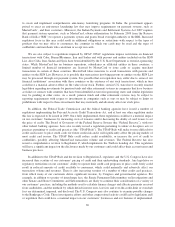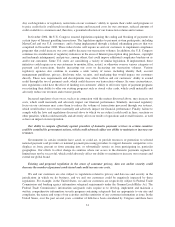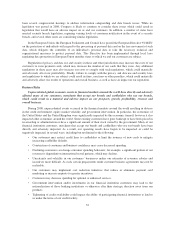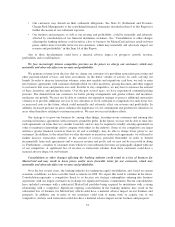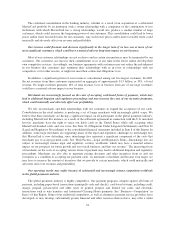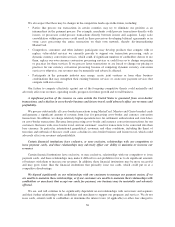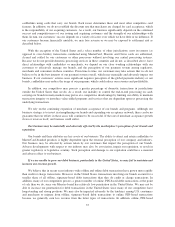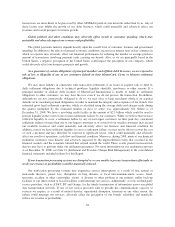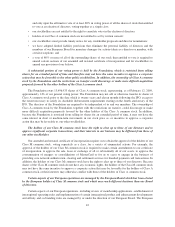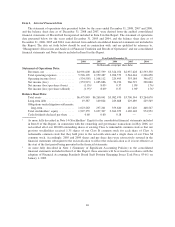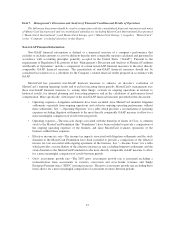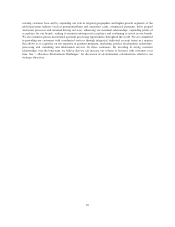MasterCard 2008 Annual Report Download - page 50
Download and view the complete annual report
Please find page 50 of the 2008 MasterCard annual report below. You can navigate through the pages in the report by either clicking on the pages listed below, or by using the keyword search tool below to find specific information within the annual report.changes in the value of only a limited number of currencies. Furthermore, we may become subject to exchange
control regulations that might restrict or prohibit the conversion of our other revenue currencies into U.S. dollars.
The occurrence of any of these factors could decrease the value of revenues we receive from our international
operations and have a material adverse impact on our business.
Any acquisitions that we make could disrupt our business and harm our financial condition.
We may evaluate or make strategic acquisitions of, or acquire interests in joint ventures or other entities
related to, complementary businesses, products or technologies. While we from time to time evaluate potential
acquisitions of businesses, products and technologies, anticipate continuing to make these evaluations, and have
made certain recent acquisitions (including interests in joint ventures and other alliances), we have no present
understandings, commitments or agreements with respect to any material acquisitions. If we do make such an
acquisition, however, we may not be able to successfully finance the business following the acquisition as a
result of costs of operations, including any litigation risk which may be inherited from the acquisition.
Furthermore, we may not be able to successfully integrate any such acquired businesses, products or
technologies. In particular, the integration of any acquisition (including efforts related to an acquisition of an
interest in a joint venture or other entity) may divert management’s time and resources from our core business
and disrupt our operations. Moreover, we may spend time and money on projects that do not increase our
revenue. In addition, to the extent we pay the purchase price of any acquisition in cash, it would reduce our cash
reserves available to us for other uses, and to the extent the purchase price is paid with our stock, it could be
dilutive to our stockholders.
Changes in the regulatory environment may adversely affect our benefit plans.
We provide certain retirement benefits to our U.S. employees through the MasterCard Accumulation Plan
(MAP), a qualified cash balance benefit plan. The Pension Protection Act of 2006 provides that, from January 29,
2005 and on, cash balance plans should not be deemed inherently age discriminatory. In addition, all five of the
U.S. Circuits that have considered the question of whether cash balance plans are age discriminatory have held
that cash balance plans do not violate the age discrimination provisions of ERISA. However, should any other
U.S. Circuit resolve the issue differently, we may be required to amend the MAP and, like other U.S. companies
with cash balance plans, may be exposed to claims from plan participants. These developments could have a
material adverse impact on our results of operations.
Risks Related to our Class A Common Stock and Governance Structure
Future sales of our shares of Class A common stock could depress the market price of our Class A
common stock.
The market price of our Class A common stock could decline as a result of sales of a large number of shares
in the market or the perception that such sales could occur. These sales, or the possibility that these sales may
occur, also might make it more difficult for us or our stockholders to sell equity securities in the future. As of
February 12, 2009, we had 98,514,196 outstanding shares of Class A common stock of which 13,496,933 shares
were owned by the Foundation. Under the terms of the donation, the Foundation may sell its shares of our
Class A common stock commencing on the fourth anniversary of the consummation of the IPO to the extent
necessary to comply with charitable disbursement requirements. Under Canadian tax law, the Foundation is
generally required each year to disburse at least 3.5% of its assets not used in administration of the Foundation in
qualified charitable disbursements. However, the Foundation has obtained permission from the Canadian tax
authorities to defer its annual disbursement requirement for up to ten years and meet its total deferred
disbursement obligations at the end of the ten-year period. Despite this permission to defer annual disbursements,
the Foundation may decide to meet its disbursement obligations on an annual basis or to settle previously
accumulated obligations during any given year. In addition, the Foundation will be permitted to sell all of the
remaining shares held by it starting twenty years and eleven months after the consummation of the IPO.
40


